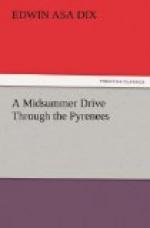The Governor of Tarbes and other knights and squires of Bigorre heard of this mischief and determined to attack the marauders. They assembled at Tournay, a town not far from Bigorre and close by Mauvoisin, and counted up two hundred men. Among them was our athletic celebrity, the Bourg d’Espaign, the same who carried the ass and wood upstairs, that Christmas Day at Orthez. He was a regiment in himself, “being well formed, of a large size, strongly made and not too much loaded with flesh; you will not find his equal in all Gascony for vigor of body.” At Tournay they prepared to lie in wait and spring on the thieving band as it returned.
The Lourdes roughs had wind of the ambush on their homeward way. They were quite as ready for a fight as a foray, but prudently divided their numbers: one detachment was to drive the booty around by the bridge half-way between Tournay and Mauvoisin and thence on through by-roads; while the main band was to march in order of battle on the high ground and so draw the attack. Both sections were later to meet at a point beyond, from whence they would soon be safely at Lourdes. “On this they departed; and there remained with the principal division Ernauton de Sainte Colombe, Le Mengeant de Sainte Basile, and full eighty companions, all men-at-arms; there were not ten varlets among them. They tightened their armor, fixed their helmets, and, grasping their lances, marched in close order, as if they were instantly to engage; they indeed expected nothing else, for they knew their enemies were in the field.”
The Bourg and his friends scented the stratagem in turn, and promptly divided themselves likewise. He himself with one division guarded the river passage, which they suspected the cattle and prisoners would be sent around to cross. The other division, under the Governor of Tarbes, took the high ground.
At the Pass of Marteras, not far from the castle, the governor’s division met the main body of the enemy. “They instantly dismounted, and leaving their horses to pasture, with pointed lances advanced, for a combat was unavoidable, shouting their cries: ‘St. George for Lourde!’ ‘Our Lady for Bigorre!’”
Now it is to be remembered that fighters in those days were often cased in armor from crown to sole,—a preposterous armor, burdensome and unwieldy, but almost utterly invulnerable. Sword-blows might dint it for hours without doing damage; the danger in battle lay chiefly in simple over-exertion. This gives the ludicrous point to the demure narration made to Froissart by his companion:
“They charged each other, thrusting their spears with all their strength, and, to add greater force, urged them forward with their breasts. The combat was very equal; and for some time none was struck down, as I heard from those present. When they had sufficiently used their spears, they threw them down, and with battle-axes began to deal out terrible blows on both sides. This action lasted for three




